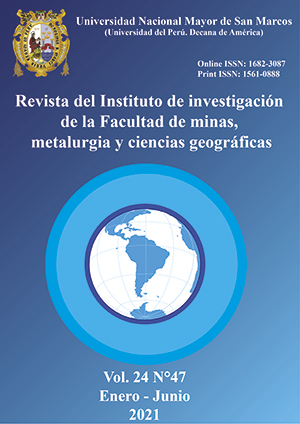Lithological and textural controls of Mississippi Valley type mineralization of mantles in Shalipayco, Junín, Peru
DOI:
https://doi.org/10.15381/iigeo.v24i47.20662Keywords:
Breccia, mineralization, lithological controlAbstract
The problem to be solved was which types of lithological, textural and structural controls were favorable to the mineralization of the Shalipayco deposit. Geochemical exploration, sedimentological studies, geological mapping, stratigraphic columns and diamond drilling were carried out, furthermore, performing surface and drill core sampling. It was found mineralized mantos of the Shalipayco project are located lithostratigraphically within the rocks of the Pucara Group, specifically in the Chambara Formation with lithological control of the mineralized mantos, they are coarse to medium grained dolomites (wackestone and packstone) present vuggy type porosity, and the most important textures favorable to the mineralization of the mantos are the evaporitic tectonic breccias, evaporitic breccias, crackel breccia, evaporitic pseudobreccias, and porous dolomites where the dissolution cavities are filled by crystallized dolomite and/or Zn and Pb sulfides. Recognized structural control of mineralization are high angle faults, finally, it has been found the following mineralized mantos, Virgencita, Intermedio and Resurgidora with clear typology of being a Mississippi Valley type deposit.
Downloads
Published
Issue
Section
License
Copyright (c) 2021 Nancy Tuanama Tuanama, Enrique Guadalupe Gómez

This work is licensed under a Creative Commons Attribution 4.0 International License.
AUTHORS RETAIN THEIR RIGHTS:
a. Authors retain their trade mark rights and patent, and also on any process or procedure described in the article.
b. Authors retain their right to share, copy, distribute, perform and publicly communicate their article (eg, to place their article in an institutional repository or publish it in a book), with an acknowledgment of its initial publication in the Rev. Inst. investig. Fac. minas metal cienc. geogr.
c. Authors retain theirs right to make a subsequent publication of their work, to use the article or any part thereof (eg a compilation of his papers, lecture notes, thesis, or a book), always indicating the source of publication (the originator of the work, journal, volume, number and date).






